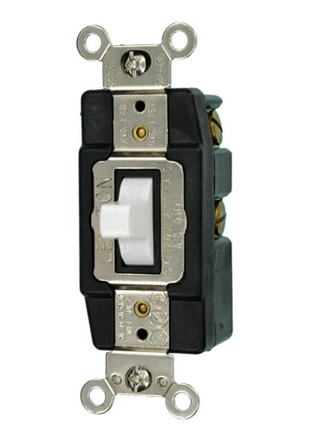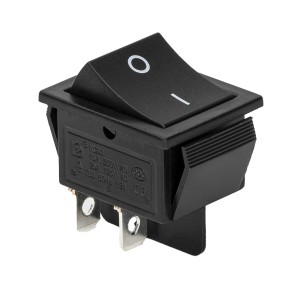In the realm of industrial automation, the choice between single pole (SP) and double pole (DP) switches plays a crucial role in designing reliable and efficient control systems. Single pole and double pole switches serve as fundamental components determining how electrical circuits open and close. In this article, we will explore the characteristics of single pole and double pole switches, their applications in industrial automation, and the considerations involved in making the right choice.
Single Pole vs Double Pole
Single pole switches (SP) and double pole switches (DP) are fundamental electrical components that control the flow of electricity in circuits, yet they differ significantly in their functionality and applications.
In terms of installation and physical appearance, both single pole and double pole switches share similarities. They are often available in similar sizes and designs, making them interchangeable in certain situations. However, the difference lies in their internal structure and functionality, impacting their capacity to manage electrical circuits.
Single Pole Switches

A single pole switch operates within a single circuit, controlling the electrical flow through one set of contacts. In residential settings, single pole switches are ubiquitous, commonly used to turn lights on and off. Their simplicity and cost-effectiveness make them suitable for basic control operations. Turning on the switch completes the circuit, allowing electricity to flow. Turning off the switch breaks the circuit, interrupting the flow of electricity. However, their limitation lies in their inability to manage multiple circuits simultaneously, which restricts their application in more complex electrical systems.
Double Pole Switches

On the other hand, double pole switches control two separate circuits independently. They contain two sets of contacts, allowing for the management of two distinct electrical paths. Double pole switches offer increased versatility and safety compared to single pole switches. Industrial settings prefer double pole switches due to their ability to isolate two circuits completely. This reduces the risk of potential hazards. Their structure allows both poles to open or close simultaneously, ensuring complete disconnection or connection of multiple circuits.
The Key Differences Between Single Pole & Double Pole Switches
One crucial difference between single pole and double pole switches is their safety and application in higher voltage systems. Single pole switches are suitable for low-voltage applications where simpler control is sufficient. Meanwhile, double pole switches excel in scenarios involving higher voltage and current ratings. Their robust construction enables them to handle more substantial electrical loads, making them indispensable in industrial automation where varying power requirements are common.
While single pole switches serve well in residential and simpler settings where cost and simplicity are priorities, double pole switches shine in industrial automation, where safety, reliability, and the need to control multiple circuits simultaneously are crucial. The choice between single pole and double pole switches ultimately depends on the specific requirements of the electrical system, balancing functionality, safety, and efficiency.
The History of Single and Double Pole Switches
The history of single and double pole switches intertwines with the evolution of electrical systems and the advancements in electrical engineering over the past century.
Single Pole Switch Origins
Single pole switches, the simpler of the two, have roots that trace back to the late 19th and early 20th centuries. As electrical systems began to replace gas lighting, early versions of single pole switches emerged to control the flow of electricity to lighting fixtures in homes and commercial spaces. Initially manual and rudimentary, these switches underwent significant development in design and functionality. The introduction of toggle switches, a type of single pole switch, in the early 20th century marked a significant advancement, providing a more convenient and standardized way to control electrical circuits.
Double Pole Switch Origins
The concept of double pole switches emerged later, stemming from the need for enhanced safety and control in electrical systems. As industrialization and technological advancements progressed, more complex electrical systems required improved methods of managing circuits. Double pole switches were developed to provide control over multiple circuits simultaneously, ensuring complete disconnection or connection of two independent electrical paths. Their design addressed safety concerns in industrial settings by minimizing the risk of partial operation or potential hazards associated with managing high-voltage circuits.
The refinement of single and double pole switches continued alongside the evolution of electrical engineering. Advancements in materials, manufacturing techniques, and safety standards led to the production of more reliable and durable switches. Additionally, the incorporation of new technologies, such as smart switches and automation features, brought further innovation to both single and double pole switches, enhancing their functionality and convenience in modern electrical systems.
The Right Switch for the Right Job
Single and double pole switches remain integral components in electrical installations across residential, commercial, and industrial settings. While single pole switches continue to serve in simpler applications due to their simplicity and cost-effectiveness, double pole switches play a crucial role in ensuring safety and reliability in more complex electrical systems, particularly in industrial automation where stringent control measures are necessary. Their evolution continues, driven by the ongoing quest for improved efficiency, safety, and adaptability in electrical control mechanisms.
MRO Electric offers a wide range of industrial automation parts, from some of the top brands in the industry. Shop our extensive selection, and contact us for a quote today!
Updated on March 26, 2024 by Leanna Cota